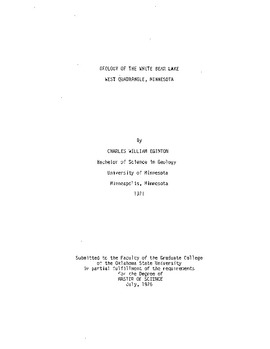| dc.contributor.advisor | Stene, John E. | |
| dc.contributor.author | Eginton, Charles William | |
| dc.date.accessioned | 2015-10-19T18:20:25Z | |
| dc.date.available | 2015-10-19T18:20:25Z | |
| dc.date.issued | 1975-07-01 | |
| dc.identifier.uri | https://hdl.handle.net/11244/20004 | |
| dc.description.abstract | This study presents a three-dimensional picture of the surficial geology and of the bedrock geology of the White Bear Lake West Quadrangle, an area in east-central Minnesota near St. Paul and Minneapolis. The Minneapolis-St. Paul area is covered by unconsolidated glacial and post-glacial deposits of variable thickness overlying a roughly circular 100-mile diameter bedrock basin warped and faulted in the Paleozoic sedimentary rocks .. The glacial deposits are primarly Wisconsinan in age and were deposited by three main lobes: the Wadena Lobe from the north, the Superior Lobe from the northeast, and the Grantsburg Sublobe from the west. Pre-Wisconsinan glacial deposits appear to exist in the buried valleys, but little is known about them. The present surface morphology of the study area is dominated by glacial features such as lake and outwash plains, and morainic topography dotted with kettle holes, lakes, and swamps. The area lacks a well integrated surface drainage pattern due in part to the nature of the glacial deposits, and to the geologically short exposure to erosion. The Twin Cities Artesian Basin is a warped and faulted sh~llow basin with approximately 1000 feet of closure. The Paleozoic strata dip approximately ten feet per mile southwestward in the White Bear Lake West Quadrangle. The area is faulted with major Precambrian faults and small scale Paleozoic and Quaternary faults. One bedrock fault is mapped in the subsurface in the study area. Its movement is consistent with the basin formation by step faulting theory.� The establishment of a depositional sequence in a glacial terrain is difficult because the units often are juxtaposed instead of superposed. The time-transgressive aspects of the till units, and the formation and disappearance of ice-marginal lakes and of outwash torrents w1th the advance and retreat of the ice sheets, produce a discontinuous character of glacial deposits that does not allow all units to occur in stratigraphic superposition in any one place. The glacial units recognized in the quadrangle, in their approximate order of formation are | |
| dc.format | application/pdf | |
| dc.language | en_US | |
| dc.publisher | Oklahoma State University | |
| dc.rights | Copyright is held by the author who has granted the Oklahoma State University Library the non-exclusive right to share this material in its institutional repository. Contact Digital Library Services at lib-dls@okstate.edu or 405-744-9161 for the permission policy on the use, reproduction or distribution of this material. | |
| dc.title | Geology of the White Bear Lake West Quadrangle, Minnesota | |
| dc.type | text | |
| dc.contributor.committeeMember | Stewart, Gary F. | |
| dc.contributor.committeeMember | Naff, John D. | |
| osu.filename | Thesis-1975-E29g.pdf | |
| osu.accesstype | Open Access | |
| dc.description.department | Geology | |
| dc.type.genre | Thesis | |
